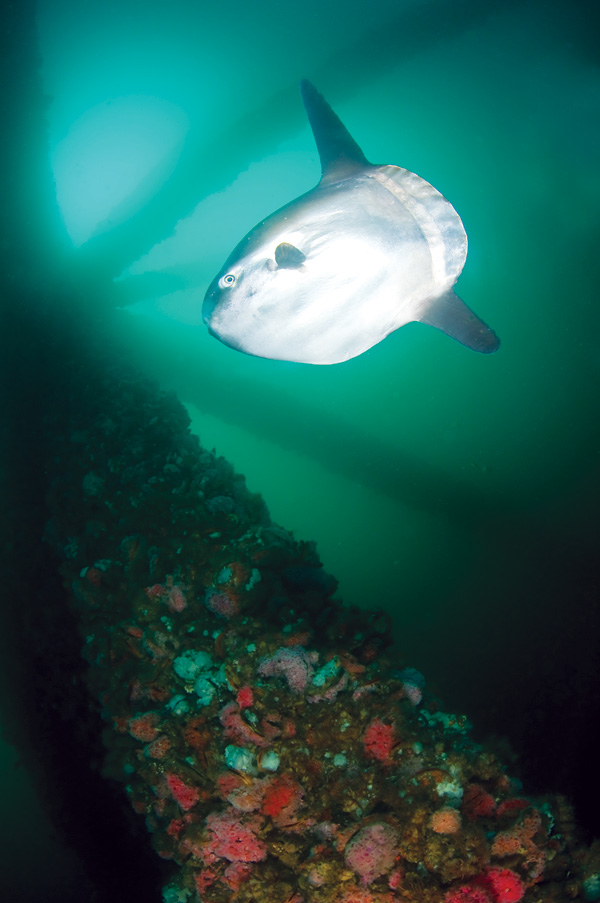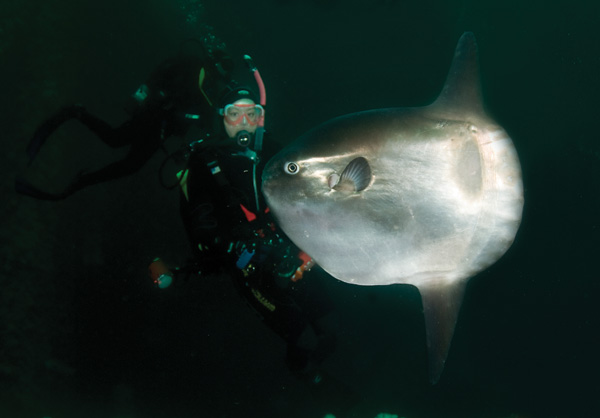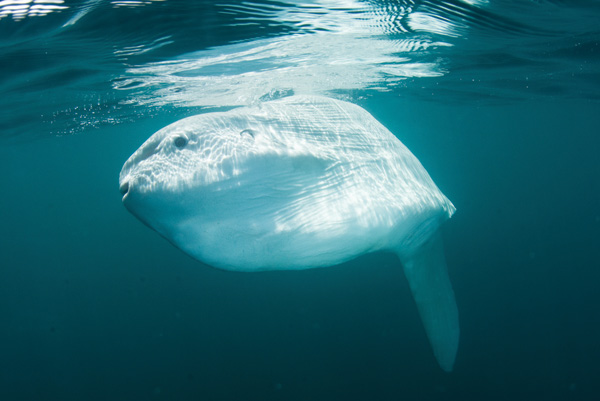I’ll be the first to admit it—fishermen aren’t the only ones who tell “fish tales.” In fact, scuba divers may be even guiltier of this indulgence. Sometimes the excitement of the moment just gives way to a little embellishment. So, I forgave my friends in advance for not believing me when I told them about the Mola mola (also known as an ocean sunfish).
 Seeing a Mola Mola for the first time would have been exciting enough. However, in Monterey’s low-visibility conditions, it looked like a shark—a very big, white shark—coming straight at me through the kelp- and particulate-clouded water. As a result, my adrenaline level was already sky-high by the time the creature got close enough for me to correctly identify it as a Mola mola, the heaviest known bony pelagic fish in the world (this category does not include sharks or rays, which do get bigger and heavier than the Mola—but are cartilaginous, not bony).
Seeing a Mola Mola for the first time would have been exciting enough. However, in Monterey’s low-visibility conditions, it looked like a shark—a very big, white shark—coming straight at me through the kelp- and particulate-clouded water. As a result, my adrenaline level was already sky-high by the time the creature got close enough for me to correctly identify it as a Mola mola, the heaviest known bony pelagic fish in the world (this category does not include sharks or rays, which do get bigger and heavier than the Mola—but are cartilaginous, not bony).
According to The Ocean Sunfish organization (http://oceansunfish.org), “the word Mola comes from Latin and means ‘millstone’–in reference to these fishes’ roundish shape. The common name ‘ocean sunfish’ comes from the Mola mola’s habit of lying atop the surface of the ocean appearing to sunbathe.” These fish usually reach at least 1,000 kg. (2,200 lb.) in weight. Although there is no data on how fast Molas grow in the wild, one in captivity at the Monterey Bay Aquarium reportedly gained 800 lbs. in 14 months. This fish—which was fed a diet of prawns and squid—had to be airlifted out by helicopter and released into the Bay after outgrowing its tank.
People often describe sharks as “prehistoric.” The Mola makes a similar impression (although having appeared about 40 million years ago, it is a relative oceanic newcomer). Up close, it looks nothing like a shark. However, from a distance, through the gloom of a low-visibility sea, its giant dorsal and anal fins (one on the top and one on the bottom) and massive body size may give a diver pause. In contrast to the infamous white shark, however, the Mola is a curious, friendly fish that poses little or no danger to humans. It drifts slowly sideways through the water, affording divers a good look at its bizarre silhouette.
As soon as the Mola was gone, I completed a safety stop, then surfaced. I was excited to tell everyone what I had seen. That’s when—for the very first time—I encountered what I will call fish “denial.” My boatmates were so jealous of my sighting that they refused to believe it had occurred.
 But I knew what I had seen, and soon I was vindicated. The boat anchored for our second dive, and we all suited up again. Hand-under-hand down the anchor line we went. Each buddy pair slowly floated off together in the same direction—across a thick kelp bed, out into an open patch of rocky white sand. There was the evidence: littered about the sandy, ocean floor were the dead and dying bodies of about five Mola molas, all missing their oversized dorsal and anal fins. I saw one covered with orange bat stars, which looked like they were feasting on the dead animal.
But I knew what I had seen, and soon I was vindicated. The boat anchored for our second dive, and we all suited up again. Hand-under-hand down the anchor line we went. Each buddy pair slowly floated off together in the same direction—across a thick kelp bed, out into an open patch of rocky white sand. There was the evidence: littered about the sandy, ocean floor were the dead and dying bodies of about five Mola molas, all missing their oversized dorsal and anal fins. I saw one covered with orange bat stars, which looked like they were feasting on the dead animal.
I signaled to my buddy, “What is this? Could it have been a shark?” I asked this last question by using my hand on top of my head to represent an exaggerated dorsal fin. My buddy shook his head, and pointed. There, about 50 feet away, was a little gang of sea lions. One was swimming with the finless head and body of a Mola mola in its mouth. My buddy made an arm motion like he was playing Frisbee.TM I looked at him quizzically. He gestured again. He was indicating that the sea lions bite the fins off of the Mola molas and toss them back and forth like flying discs! I looked back in the direction of the sea lions and cleared my mask. He was right. The lumbering pinipeds were, indeed, playing with the poor, mutilated Molas.
We saw a number of interesting types of life that day, including some 20-foot long white tubeworms, but nothing could compete with the sight of those strange, flat sunfish dying on the ocean floor. After our group surfaced, I suppressed the urge to utter a ceremonial “I told you so.” They believed me now—I had seen a Mola mola after all. I didn’t need to drive the point home. Instead I peeled my wetsuit off down to my waist and sat back in silent (but smug) fish-spotting satisfaction.
Mola Mola Facts
According to the Monterey Bay Aquarium, because Molas spend so much time drifting near the ocean surface, they are vulnerable to fishing boats that use drift gillnets. In California, nearly 30 percent of the catch in a swordfish boat can be molas caught by mistake—rivaling or exceeding the number of swordfish caught. A pelagic (open ocean) fish, the Mola mola is found in all tropical and temperate oceans.
About the author: Brianna Politzer Stevens, M.A., is a journalist and PADI Divemaster in the San Francisco Bay Area who gets up-close-and-personal with any Mola mola that will let her.
Photography by Scott Gietler
Scott Gietler is the publisher of the Underwater Photography Guide and the owner of Bluewater Photo & Video in Santa Monica, CA
Found on Youtube – linked below:
—————————————————————————————————————-

